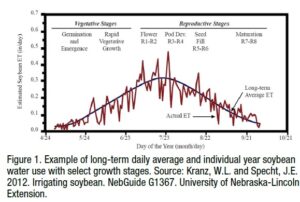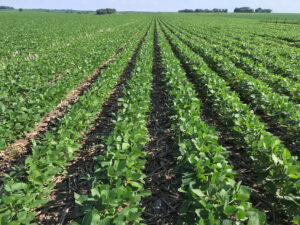Soybean water use will fluctuate throughout the season depending on weather conditions and crop growth stages. The mid- to late-reproductive growth stages are the most sensitive to water stress. When soybean does not receive enough water to meet evapotranspiration (ET) demands during the reproductive growth stages, significant reductions in yield can occur. An understanding of soybean water use can help guide the development of more efficient irrigation strategies.
Basics of Evapotranspiration
Evapotranspiration (ET)
Crop water use, or evapotranspiration (ET), is the movement of water through evaporation (E) from the soil and leaf surfaces and transpiration (T) through the plant. Transpiration is the movement of water from the soil into plant roots, continuing through stems and leaves to the atmosphere. Transpiration is an important concept because yield is linearly related to the amount of water a soybean plant transpires.
Factors Influencing ET
Water use by the soybean crop will fluctuate throughout the season depending on weather conditions and growth stage (Figure 1). Factors that will affect ET and irrigation decisions include:
Crop growth stage. Crop water requirements vary depending on growth stage (Table 1). Younger, smaller plants transpire less than older, larger plants due to a smaller leaf surface area. Soybean plants require the most water from flowering through seed fill.
Weather conditions. The ability of the atmosphere to evaporate water is the driving force for ET. Daily ET is influenced by solar radiation, air temperature, relative humidity, and wind. Evaporative demand increases as air temperature and windspeed increase and humidity decreases.



Factors influencing soil water content
Soil water holding capacity. The water holding capacity of a soil is primarily determined by its texture. The field capacity of a soil is defined as the amount of water that a soil can hold against gravity after all excess water has been removed. Coarse soils (e.g., fine sand, loamy sand, sandy loam) will typically hold 1.5 inches or less per foot of soil. Finer textured soils, such as silty clay loam, are considered to hold about 1.8 inches per foot of soil, while others such as silt loam or loams often hold about 2.0 inches per foot. At field capacity, plants may be able to use water at a maximum rate. As the soil dries, it becomes more difficult for plants to extract water from the soil. Therefore, plants use less water as the water content of the soil declines. It is important to note that while soybean plants can have roots as deep as five feet, for purposes of irrigation scheduling, growers should consider only the top 2 feet of the soil profile through R2, and the upper 3 feet of the profile for the R3 and later growth stages
Residue management/tillage system. Minimizing soil disturbance from tillage and increasing surface crop residue can reduce soil water evaporation. Reduced-tillage practices, particularly no-till and strip tillage, can help the soil capture and retain more moisture. Tillage may increase the exposed surface area of the soil which can lead to greater amounts evaporation as well as surface runoff. It also destroys crop residue that can capture snow through the winter. Additional effects of tillage include the breakdown of physical soil properties and increasing the likelihood of soil compaction, both of which can reduce water infiltration.
Crop residue remaining on the soil surface helps improve water infiltration rates by limiting the amount of surface sealing created by the physical impact of rainfall or irrigation droplets. Residue also helps decrease runoff by creating obstructions that can slow the speed of water movement across the soil surface, therefore allowing more time for water to infiltrate the soil profile.
Irrigation Scheduling for Soybean
Soybean Water Use and Irrigation Scheduling by Growth Stage
Estimated seasonal water requirements for soybean range from 20 to 26 inches depending on planting date, maturity, growth stage, location, and weather.1,2 The most critical time to avoid water stress is during the mid- to late-reproductive stages. By keeping track of the loss of soil water through ET, you can determine the amount of water remaining for plant use. When soil water content reaches the maximum allowable depletion (MAD) level, water should be applied. In most cases, growers should use a MAD of 50% as a threshold for initiating irrigation. For example, a silt loam soil with a water holding capacity of 2.0 inches per foot would have a total of 6.0 inches of stored water at field capacity in the top 3 feet of the profile. With a MAD of 50%, three inches of water would have been depleted from the profile, which in turn would indicate that irrigation water should be applied. When soybean plants do not receive enough water to meet ET demands during this critical water use period, substantial reductions in yield can occur.
Emergence and vegetative stages
Soybean uses very little water during the seedling stage. Estimates for total consumptive water use from emergence through V6 is about 3.0 inches. Unless the soil is extremely dry, supplemental irrigation is generally not needed during germination or the vegetative growth stages. Too much water early in the season can prolong the vegetative growth stage, which can result in delays in flowering, increase plant height, and lodging.2 In addition, unnecessary irrigation early in the season can also increase the incidence and severity of root and crown rot diseases. Limiting early-season irrigation can stimulate soybean plants to develop stronger, healthier root systems that penetrate deeper into the soil profile. Farmers should rely on stored soil moisture and natural precipitation as much as possible during early growth stages.
Reproductive stages to maturity
The early reproductive (R) stages of soybean begin when flowers start to form (R1), continuing on to full flowering (R2) (Figure 2). During these
early reproductive stages, daily water use (ET) can approach .25 inches of water per day. Total consumptive water use by the crop during R1 and R2 stages is estimated to be about 3.75 inches. During the mid- to late-reproductive stages, which includes pod development (R3 to R4) and seed fill (R5 to R6), soybean is most sensitive to water stress (Figure 3). On average, daily water use increases to about .32 inches per day during the R3 through R5 stages, then begins to decline at R6. In extreme cases of hot and windy conditions, daily ET may approach .50 inches per day. The total amount of water consumed from R3 through R6 may be 13.5 inches or higher. As a guideline, growers should expect that about 65% of all the water used by a soybean crop will be consumed from R1 through R6.2 Therefore, water stress during pod development and early seed fill can have the greatest negative impact on yield potential because of a reduced number of seeds per pod and/or reduced seed size. Irrigation may be required during flowering on soils with an insufficient water holding capacity (coarse soils) or when conditions are exceptionally dry.2 When water is applied during flowering, it is especially important to also supply adequate water during seed fill. This is because irrigation during flowering usually increases the number of seeds produced, but subsequent water stress during seed fill will reduce the seed size which can result in greater yield penalties than would have occurred if the crop had not been watered at all during flowering.
Soybeans require adequate water through the reproductive stages for seeds to achieve their maximum weight. It is estimated that soybeans require about 3.5 inches from the conclusion of seed enlargement (R6) through physiological maturity.3 Discontinuing irrigation before physiological maturity can result in yield penalties if the soil water content is not sufficient.

Figure 2. Soybean flowers (R1/R2 growth stages).

Figure 3. Beginning seed (R5 growth stage).
Plan Ahead to Avoid Water Stress
It is important to know when crop water demands will be greater than the amount supplied by precipitation, which often occurs during the critical reproductive periods. Plan ahead by knowing the capacity of the irrigation system to ensure that adequate water is available to the crop through maturity.
